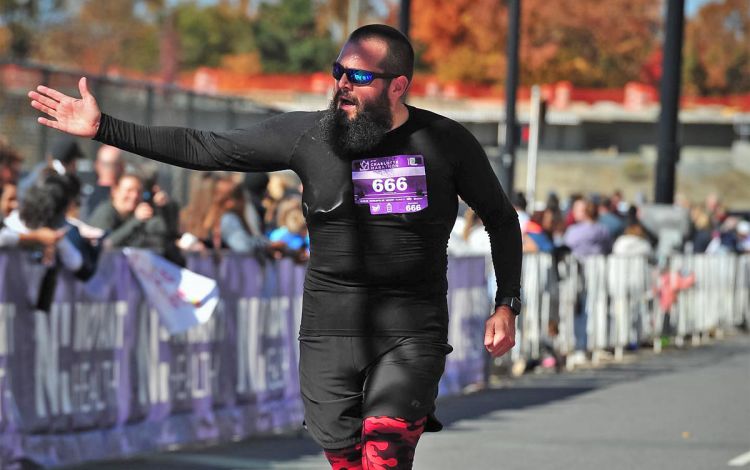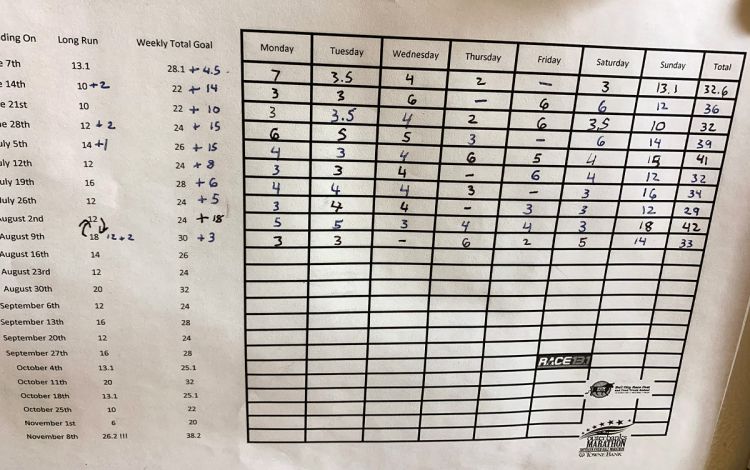About four years ago, Lee Walls fell in love with running.
What started as a step toward getting healthier by running a few miles near his home turned into a refuge from the stressors of daily life.
“Just being alone, on a road with a curated playlist was just a really good way for me to clear my head,” said Walls, IT analyst with Duke’s Office of Information Technology.
Somewhere along the way, the idea of running a marathon got into his head. He built a training plan on a spreadsheet and stuck a printout on the fridge. After months of work, he ran his first marathon in Wilmington in November 2020; the second on the American Tobacco Trail in April of 2021; and his third in Charlotte last November.
“I loved every minute of it,” Walls said.
 With warm weather and a gradual return to some pre-pandemic rhythms, many in the Duke community are reviving fitness routines, or starting new ones, so staying injury-free is key.
With warm weather and a gradual return to some pre-pandemic rhythms, many in the Duke community are reviving fitness routines, or starting new ones, so staying injury-free is key.
“Any activity level, as long as it’s safe, is ideal,” said Tim Bisantz, fitness program manager for LIVE FOR LIFE, Duke’s employee wellness program. “With busy schedules, the need for work-life balance and the demands of taking care of a family, any physical activity that people can pursue and enjoy is important. And making it a part of the routine, and expand on it, can be essential for personal health and wellness.”
Here are simple tips from Duke colleagues who make physical activity a big part of their lives and how they’ve taken on challenges and remained injury-free.
High on Hydration
 When it comes to athletic thrills, Duke Interdisciplinary Priorities Coordinator Amy Feistel finds hers in the passenger seat of powerful, nimble cars rocketing around tight turns and over gut-churning hills. The motorsport of rallying features two people – one navigator and one driver – teaming up to guide cars on timed circuits of white-knuckle courses or on marathon journeys across rugged landscapes.
When it comes to athletic thrills, Duke Interdisciplinary Priorities Coordinator Amy Feistel finds hers in the passenger seat of powerful, nimble cars rocketing around tight turns and over gut-churning hills. The motorsport of rallying features two people – one navigator and one driver – teaming up to guide cars on timed circuits of white-knuckle courses or on marathon journeys across rugged landscapes.
 For the past several years, Feistel has served as the navigator for different drivers in races in New York, Tennessee and elsewhere along the east coast, studying courses beforehand and speaking precise moment-by-moment directions during the race.
For the past several years, Feistel has served as the navigator for different drivers in races in New York, Tennessee and elsewhere along the east coast, studying courses beforehand and speaking precise moment-by-moment directions during the race.
“It’s pretty cerebral, it’s about timing, it’s about understanding the vehicle and teamwork,” Feistel said. “There are so many different pieces of it that I really enjoy.”
In addition to the ability to stay calm when buzzing with adrenaline, rallying also requires navigator to be fit enough to endure the jostling of the ride, where cars can reach 80 miler per hour, and the heat of the fireproof suit.
Feistel uses yoga and weight training to help with core strength and balance. But when it comes to staying hydrated during a race, she knows that it involves more than having water in the car.
Cheyanne Oakley, a Duke Health & Fitness Center exercise physiologist who helps clients create and implement fitness plans into their lives, points out that hydration helps athletic performance by keeping joints lubricated, keeping your body cool and helping key cellular functions, such as those involved with burning fat, going.
 “Water is necessary for all of our bodily functions,” Oakley said. “When you exercise, you’re actively losing water. So water content, when it’s low, negatively impacts your body and it’s hard for it to function effectively.”
“Water is necessary for all of our bodily functions,” Oakley said. “When you exercise, you’re actively losing water. So water content, when it’s low, negatively impacts your body and it’s hard for it to function effectively.”
But in order to reap the benefits of hydration, you need to make sure the fluids you drink are fully absorbed. To do this, drink fluids slowly throughout the day, and consume plenty well before your exercise. The Institute of Medicine recommends that adult women consume around 2.7 liters of water from all sources during the course of a day; adult men should consume around 3.7 liters.
“Paying attention to hydration is important, but it’s something you have to do in advance,” Feistel said. “When I’m coming up on a competition, I start thinking about it two or three days ahead of time.”
Secret of Stretching
 Whether she’s running or hiking, Meera Gandhi, physician assistant at Duke Urgent Care Croasdaile, lives to be outside.
Whether she’s running or hiking, Meera Gandhi, physician assistant at Duke Urgent Care Croasdaile, lives to be outside.
Her hikes, which range between five and 10 miles, have taken her to Alaska, California, the Himalayas, the Andes and Costa Rica. But she understands that the thing that can stifle her wanderlust is injury. That’s why she makes sure to stretch out the muscles in her legs before, and after, each run or hike.
“I’m getting older, and I’m finding that I’m a little more injury prone,” said Gandhi, 34. “So I know stretching is incredibly important.”
Oakley said warming up prior to exercising with dynamic stretching, or moving your joints through their full range of motion, is preferable to stretching cold muscles, which can lead to injury. Instead of simply stretching muscles, LIVE FOR LIFE’s Bisantz suggests trying jumping jacks, squats or arm circles as movements which can get your heart rate up while also warming up key muscle groups.
And after a workout, stretching muscles far enough to feel tension – but not discomfort – can help you build flexibility and reduce your risk of injury moving forward.
“After you’ve been exercising, it can sometimes be hard for your muscles to fully relax after they’ve been put under that stress,” Oakley said. “So taking time to stretch out your muscles and force them to lengthen out all the way, gives them a chance to relax and relieve tension. That’s really important for preventing muscle soreness and preventing injury.”
Build to Your Goals Gradually
 When Duke OIT’s Lee Walls started running seriously in 2018, he was only able to run two or three miles at a time. When he set the goal of completing a marathon, which is 26.2 miles, it seemed borderline impossible.
When Duke OIT’s Lee Walls started running seriously in 2018, he was only able to run two or three miles at a time. When he set the goal of completing a marathon, which is 26.2 miles, it seemed borderline impossible.
But Walls gave himself plenty of time – roughly six months – and stuck to a plan, adding distance to his runs slowly, until the longer 16- and 20-mile training runs didn’t seem so daunting. His approach worked as he stayed injury-free and was ready when race day arrived.
“I just made my plan and stuck with it,” Walls said.
 Whether you’re planning something ambitious or just hoping to weave more movement into your day, it’s important to follow Walls’ gradual approach to avoid putting too much strain on your body. One common approach is to increase the time or intensity of your exercise by small increments each week. For example, if you’re training for a race, try push the distances of your long runs slowly. If you run five miles one week, do five and a half the next. Then try six miles a week later.
Whether you’re planning something ambitious or just hoping to weave more movement into your day, it’s important to follow Walls’ gradual approach to avoid putting too much strain on your body. One common approach is to increase the time or intensity of your exercise by small increments each week. For example, if you’re training for a race, try push the distances of your long runs slowly. If you run five miles one week, do five and a half the next. Then try six miles a week later.
Quickly adding too many miles to your runs, or too much time working out, can increase the risk of injury to joints and muscles that aren’t able to adjust to the increased stress.
LIVE FOR LIFE’s Bisantz said it’s also helpful to document your progress. Whether you write the length or duration of your workouts on a sheet of paper – like Walls did for his marathon training – or with the help of a watch or phone app which counts your steps or logs your workouts, having a record of your progress helps with inspiration and accountability.
“Regardless of what you’re doing, if you keep track of it, you can see how much more you’re doing,” Bisantz said. “If you’re able to document your progress, it can make a huge difference. It’s a snowball effect. It can help you stay consistent.”
Send story ideas, shout-outs and photographs through our story idea form or write working@duke.edu.
from WordPress https://ift.tt/2rO19Ry
via IFTTT

0 Comments